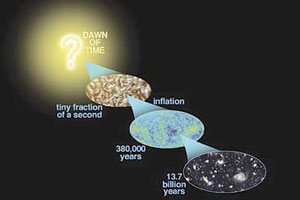Probe captures early image of universe– as it looked 380,000 years after big bang
By Steve KoppesNews Office
 A cosmic history, illustrated above, shows the first light of the universe–the afterglow of the big bang, which the WMAP observed. This light emerged 380,000 years after the big bang. Patterns imprinted on the light, which are shown in the first ellipse, encode the events that happened only a tiny fraction of a second after the big bang. In turn, the patterns are the seeds of development for galaxies we now see billions of years after the big bang. |
It was as if the scientists had taken a photograph of what they thought was a blond child and the picture showed a redhead instead.
“I find that really quite amazing,” said Stephan Meyer, Professor in Astronomy & Astrophysics and the College. “I sense in that something fundamental.”
The cosmic portrait–taken by NASA’s Wilkinson Microwave Anistropy Probe–shows the universe as it looked 380,000 years after the big bang, some 200 million years before any stars or galaxies had formed.
Meyer serves as a member of the probe’s science team and presented WMAP’s first results during a special seminar before approximately 150 students and faculty members in the Biological Sciences Learning Center on Wednesday, Feb. 12. NASA announced the results simultaneously during a news conference in Washington, D.C.
The probe imaged the entire sky for a full year, producing a detailed picture of the cosmic microwave background, the afterglow of the big bang. The incomparable heat of the big bang has cooled to a mere 2.73 degrees above absolute zero, but WMAP can detect temperature variations of millionths of a degree. Within these variations were the seeds that later grew into stars, galaxies and clusters of galaxies that populate the universe today.
What Meyer found so amazing in the WMAP data was no sign of any correlation between temperature variations in far-flung parts of the sky.
“The temperature in Chicago has something to do with the temperature in Springfield. They’re not completely separated,” Meyer said. “In the microwave sky we have the same kind of thing.”
There should be a cause-and-effect relationship between distant sections of sky, Meyer said, “and we just don’t see it. It’s as though somehow there’s a wall that has separated things beyond a certain point. The question is whether there is some physics behind that or whether it’s just a chance occurrence.”
 This full-sky map is the “baby picture” that was captured by the WMAP during its orbit. The red color indicates warmer spots and the blue color indicates cooler areas. It shows the oldest light in the universe. |
Meyer plans to devote future attention to studying emissions that WMAP recorded from the Milky Way galaxy. Scientists actually had to erase the glare of those emissions from their data in order to closely examine the temperature fluctuations in the cosmic microwave background radiation.
“There is actually a lot of interesting physics in the study of the galaxy itself,” Meyer said.
But Meyer also will examine WMAP data for signs of polarized light. Unlike most light waves, which flicker up and down in randomly oriented planes, polarized light waves flicker up and down in the same plane.
“That’s the place where the best gains are going to be because the polarization signal says we have seen the first star formation.”
Launched in June 2001, WMAP maintains an orbit a million miles from Earth, or approximately five times the distance from Earth to the moon. The probe is named for the late David Wilkinson, who was Meyer’s mentor and thesis adviser at Princeton University.
Wilkinson served as a Distinguished Visiting Professor at the Enrico Fermi Institute in 1994. Meyer said he remembers seeing Wilkinson working in his office in the Research Institutes on designs of WMAP’s instrumentation.
“He was calculating and figuring out exactly how it would work and what would be the pitfalls,” Meyer said. “Not only did he do the design of the instrument, he actually did it here while he was on a sabbatical for half a year.”
WMAP, which is scheduled to operate for another three years, is the successor to the Cosmic Microwave Background Explorer mission. Meyer was a member of the COBE science team that created a sensation in 1992 by detecting the first fluctuations in the cosmic microwave background.
![[Chronicle]](/images/sidebar_header_oct06.gif)